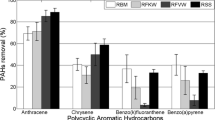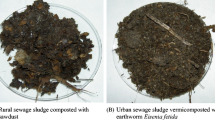Abstract
In this study, greenhouse experiments were conducted under the condition of different amendment ratios and planting tall fescue (Festuca arundinacea). The amendment ratios of sewage sludge or sludge compost to soil were of 0, 10, 25, and 50% (w/w). The removal rates of PAH, catalase, and dehydrogenase activities of amended soil and accumulation of PAHs by vegetation were detected to investigate the differences of PAH dissipation in sludge-amended and compost-amended soils. The initial PAH concentrations in three amended soils increased with the more addition of sludge or compost. After 126-day experiment, maximum PAH removal rates were observed in sludge-amended and compost-amended soils with PAH concentration of about 200 μg kg−1. And the removal of PAHs showed better efficiencies in compost soil rather than in sludge soil. The more catalase activity and dehydrogenase activity of soil were obtained, respectively, in sludge soil and compost soil. The results indicated that the mechanism of PAH dissipation in two types of amended soils were different. The abundant amount of microorganism dominated PAH dissipation in sludge soils, and PAHs dissipated mainly caused of intense activity of microorganism in compost soils. In addition, PAH accumulation in tall fescue suggested that the transference approach of PAHs was from soil to the roots, and then accumulated in the shoots of tall fescue. It was prone to store up more PAHs in vegetation in the condition of high molar weight of PAHs, more biomass of vegetation, and heavy PAH concentration in soil.




Similar content being viewed by others
References
Alegbeleye OO, Opeolu BO, Jackson VA (2017) Polycyclic aromatic hydrocarbons: a critical review of environmental occurrence and bioremediation. Environ Manag 60:758–783. https://doi.org/10.1007/s00267-017-0896-2
Baldantoni D, Morelli R, Bellino A, Prati MV, Alfani A, de Nicola F (2017) Anthracene and benzo(a)pyrene degradation in soil is favoured by compost amendment: perspectives for a bioremediation approach. J Hazard Mater 339:395–400. https://doi.org/10.1016/j.jhazmat.2017.06.043
Bellino A, Baldantoni D, De Nicola F et al (2014) Compost amendments in agricultural ecosystems: confirmatory path analysis to clarify the effects on soil chemical and biological properties. J Agric Sci 153:282–295. https://doi.org/10.1017/s0021859614000033
Bielska L, Kah M, Sigmund G et al (2017) Bioavailability and toxicity of pyrene in soils upon biochar and compost addition. Sci Total Environ 595:132–140. https://doi.org/10.1016/j.scitotenv.2017.03.230
Chen M, Xu P, Zeng G, Yang C, Huang D, Zhang J (2015) Bioremediation of soils contaminated with polycyclic aromatic hydrocarbons, petroleum, pesticides, chlorophenols and heavy metals by composting: applications, microbes and future research needs. Biotechnol Adv 33:745–755. https://doi.org/10.1016/j.biotechadv.2015.05.003
Covino S, Fabianova T, Kresinova Z et al (2016) Polycyclic aromatic hydrocarbons degradation and microbial community shifts during co-composting of creosote-treated wood. J Hazard Mater 301:17–26. https://doi.org/10.1016/j.jhazmat.2015.08.023
Cristaldi A, Conti GO, Jho EH, Zuccarello P, Grasso A, Copat C, Ferrante M (2017) Phytoremediation of contaminated soils by heavy metals and PAHs. A brief review. Environ Biotechnol Innov 8:309–326. https://doi.org/10.1016/j.eti.2017.08.002
Diacono M, Montemurro F (2010) Long-term effects of organic amendments on soil fertility. A review. Agron Sustain Dev 30:401–422. https://doi.org/10.1051/agro/2009040
Feng L, Zhang L, Feng L (2014) Dissipation of polycyclic aromatic hydrocarbons in soil amended with sewage sludge compost. Int Biodeterior Biodegrad 95:200–207. https://doi.org/10.1016/j.ibiod.2014.04.012
Fernández-Luqueño F, Valenzuela-Encinas C, Marsch R, Martínez-Suárez C, Vázquez-Núñez E, Dendooven L (2011) Microbial communities to mitigate contamination of PAHs in soil-possibilities and challenges: a review. Environ Sci Pollut Res 18:12–30. https://doi.org/10.1007/s11356-010-0371-6
Fu D, Teng Y, Shen Y, Sun M, Tu C, Luo Y, Li Z, Christie P (2011) Dissipation of polycyclic aromatic hydrocarbons and microbial activity in a field soil planted with perennial ryegrass. Front Environ Sci Eng 6:330–335. https://doi.org/10.1007/s11783-011-0366-7
García-Gil JC, Plaza C, Soler-Rovira P et al (2010) Long-term effects of municipal solid waste compost application on soil enzyme activities and microbial biomass. Soil Biol Biochem 32:1907–1913. https://doi.org/10.1016/S0038-0717(00)00165-6
Ginkel CGV, Louwerse A, Togt BVD (2008) Substrate specificity of a long-chain alkylamine-degrading Pseudomonas sp isolated from activated sludge. Biodegradation 19:129–137. https://doi.org/10.1007/s10532-007-9120-z
Gworek B, Klimczak K, Kijeńska M, Gozdowski D (2016) Comparison of PAHs uptake by selected Monocotyledones and Dicotyledones from municipal and industrial sewage sludge. Environ Sci Pollut Res 23:19461–19470. https://doi.org/10.1007/s11356-016-7130-2
Jones S, Bardos RP, Kidd PS, Mench M, de Leij F, Hutchings T, Cundy A, Joyce C, Soja G, Friesl-Hanl W, Herzig R, Menger P (2016) Biochar and compost amendments enhance copper immobilisation and support plant growth in contaminated soils. J Environ Manag 171:101–112. https://doi.org/10.1016/j.jenvman.2016.01.024
Jorge-Mardomingo I, Soler-Rovira P, Casermeiro MA, de la Cruz MT, Polo A (2013) Seasonal changes in microbial activity in a semiarid soil after application of a high dose of different organic amendments. Geoderma 206:40–48. https://doi.org/10.1016/j.geoderma.2013.04.025
Kapanen A, Vikman M, Rajasarkka J et al (2013) Biotests for environmental quality assessment of composted sewage sludge. Waste Manag 33:1451–1460. https://doi.org/10.1016/j.wasman.2013.02.022
Liu SH, Zeng GM, Niu QY, Liu Y, Zhou L, Jiang LH, Tan XF, Xu P, Zhang C, Cheng M (2017) Bioremediation mechanisms of combined pollution of PAHs and heavy metals by bacteria and fungi: a mini review. Bioresour Technol 224:25–33. https://doi.org/10.1016/j.biortech.2016.11.095
Mailler R, Gasperi J, Chebbo G, Rocher V (2014) Priority and emerging pollutants in sewage sludge and fate during sludge treatment. Waste Manag 34:1217–1226. https://doi.org/10.1016/j.wasman.2014.03.028
Ozaki N, Nakazato A, Nakashima K, Kindaichi T, Ohashi A (2017) Loading and removal of PAHs, fragrance compounds, triclosan and toxicity by composting process from sewage sludge. Sci Total Environ 605-606:860–866. https://doi.org/10.1016/j.scitotenv.2017.06.165
Polyak YM, Bakina LG, Chugunova MV, Mayachkina NV, Gerasimov AO, Bure VM (2018) Effect of remediation strategies on biological activity of oil-contaminated soil—a field study. Int Biodeterior Biodegrad 126:57–68. https://doi.org/10.1016/j.ibiod.2017.10.004
Ros M, Rodríguez I, García C, Hernández MT (2014) Bacterial community in semiarid hydrocarbon contaminated soils treated by aeration and organic amendments. Int Biodeterior Biodegrad 94:200–206. https://doi.org/10.1016/j.ibiod.2014.07.018
Sigmund G, Poyntner C, Pinar G et al (2018) Influence of compost and biochar on microbial communities and the sorption/degradation of PAHs and NSO-substituted PAHs in contaminated soils. J Hazard Mater 345:107–113. https://doi.org/10.1016/j.jhazmat.2017.11.010
Sun TR, Cang L, Wang QY, Zhou DM, Cheng JM, Xu H (2010) Roles of abiotic losses, microbes, plant roots, and root exudates on phytoremediation of PAHs in a barren soil. J Hazard Mater 176:919–925. https://doi.org/10.1016/j.jhazmat.2009.11.124
Taiwo AM, Gbadebo AM, Oyedepo JA, Ojekunle ZO, Alo OM, Oyeniran AA, Onalaja OJ, Ogunjimi D, Taiwo OT (2016) Bioremediation of industrially contaminated soil using compost and plant technology. J Hazard Mater 304:166–172. https://doi.org/10.1016/j.jhazmat.2015.10.061
Urbaniak M, Wyrwicka A, Toloczko W et al (2017) The effect of sewage sludge application on soil properties and willow (Salix sp.) cultivation. Sci Total Environ 586:66–75. https://doi.org/10.1016/j.scitotenv.2017.02.012
Vázquez-Cuevas GM, Stevens CJ, Semple KT (2018) Enhancement of 14 C-phenanthrene mineralisation in the presence of plant-root biomass in PAH-NAPL amended soil. Int Biodeterior Biodegrad 126:78–85. https://doi.org/10.1016/j.ibiod.2017.09.021
Wallisch S, Gril T, Dong X, Welzl G, Bruns C, Heath E, Engel M, Suhadolc M, Schloter M (2014) Effects of different compost amendments on the abundance and composition of alkB harboring bacterial communities in a soil under industrial use contaminated with hydrocarbons. Front Microbiol 5:96. https://doi.org/10.3389/fmicb.2014.00096
Waqas M, Li G, Khan S, Shamshad I, Reid BJ, Qamar Z, Chao C (2015) Application of sewage sludge and sewage sludge biochar to reduce polycyclic aromatic hydrocarbons (PAH) and potentially toxic elements (PTE) accumulation in tomato. Environ Sci Pollut Res 22:12114–12123. https://doi.org/10.1007/s11356-015-4432-8
Wawra A, Friesl-Hanl W, Puschenreiter M, Soja G, Reichenauer T, Roithner C, Watzinger A (2018) Degradation of polycyclic aromatic hydrocarbons in a mixed contaminated soil supported by phytostabilisation, organic and inorganic soil additives. Sci Total Environ 628-629:1287–1295. https://doi.org/10.1016/j.scitotenv.2018.02.156
Wloka D, Placek A, Rorat A et al (2017) The evaluation of polycyclic aromatic hydrocarbons (PAHs) biodegradation kinetics in soil amended with organic fertilizers and bulking agents. Ecotoxicol Environ Saf 145:161–168. https://doi.org/10.1016/j.ecoenv.2017.07.021
Wu M, Dick WA, Li W, Wang X, Yang Q, Wang T, Xu L, Zhang M, Chen L (2016) Bioaugmentation and biostimulation of hydrocarbon degradation and the microbial community in a petroleum-contaminated soil. Int Biodeterior Biodegrad 107:158–164. https://doi.org/10.1016/j.ibiod.2015.11.019
Wu D, Chu S, Lai C, Mo Q, Jacobs DF, Chen X, Zeng S (2017) Application rate and plant species affect the ecological safety of sewage sludge as a landscape soil amendment. Urban For Urban Green 27:138–147. https://doi.org/10.1016/j.ufug.2017.07.003
Wyrwicka A, Urbaniak M (2018) The biochemical response of willow plants (Salix viminalis L.) to the use of sewage sludge from various sizes of wastewater treatment plant. Sci Total Environ 615:882–894. https://doi.org/10.1016/j.scitotenv.2017.10.005
Yang CW, Hsiao WC, Fan CH et al (2016) Bacterial communities associated with sulfonamide antibiotics degradation in sludge-amended soil. Environ Sci Pollut Res 23:19754–19763. https://doi.org/10.1007/s11356-016-7187-y
Zheng G, Wang T, Niu M, Chen X, Liu C, Wang Y, Chen T (2018) Biodegradation of nonylphenol during aerobic composting of sewage sludge under two intermittent aeration treatments in a full-scale plant. Environ Pollut 238:783–791. https://doi.org/10.1016/j.envpol.2018.03.112
Zhu F, Storey S, Ashaari M et al (2016) Benzo(a)pyrene degradation and microbial community responses in composted soil. Environ Sci Pollut Res 24:5404–5414. https://doi.org/10.1007/s11356-016-8251-3
Funding
This work was supported by the Basic Research Project of Guizhou province (Qian Sci. Co. Basic, [2017]1123), the Science and Technology Cooperation Project of Guizhou province (Qian Sci. Co. LH [2016]7215), the Doctoral Research Project in 2014 of Guizhou Normal University, and the Key Project of Science and Technology Foundation, Guizhou Province (Qian Sci. Co. JZ, [2014], No. 2012).
Author information
Authors and Affiliations
Corresponding author
Additional information
Responsible editor: Zhihong Xu
Rights and permissions
About this article
Cite this article
Feng, LJ., Zhang, LQ., Feng, L. et al. Dissipation of polycyclic aromatic hydrocarbons (PAHs) in soil amended with sewage sludge and sludge compost. Environ Sci Pollut Res 26, 34127–34136 (2019). https://doi.org/10.1007/s11356-018-3383-2
Received:
Accepted:
Published:
Issue Date:
DOI: https://doi.org/10.1007/s11356-018-3383-2




